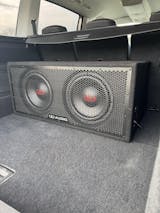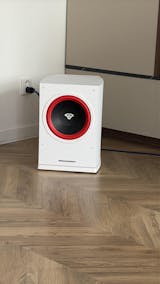The perfect calibration for your Carhifi: tips & tricks

Basics of car HIFI calibration
Understand important terms and concepts: HRTF, delay correction, crossovers
Successful calibration of Carhifi requires an understanding of some important terms and concepts. The first concept is the HRTF (Head-Related Transfer Function). This is the acoustic transfer function of the body and ears that is affected by the perception of sound. Another concept is delay correction, which helps to ensure that the sound source reaches the ear at the right time, thereby improving sound quality. Crossovers are another concept used in the Carhifi set-up. They allow certain frequency ranges of the audio signal to be sent to different speakers in the car in order to achieve optimum sound quality.
The importance of correct calibration for sound quality
Correct calibration of Carhifi is crucial for the sound quality. Poor calibration can severely affect the sound quality of the sound system, making the music experience less enjoyable. A correctly calibrated Carhifi system, on the other hand, produces a room-filling sound image that offers the listener a sound experience that meets the highest standards.
Basic equipment for car HIFI calibration: microphone, calibration software, laptop, terminals
A few tools are required to achieve a successful Carhifi calibration. The basic equipment for a Carhifi optimization includes a microphone that is placed as close as possible to the listener, calibration software and a laptop on which it is installed. This makes it easy to record and analyze acoustic data and settings. Terminals are also an indispensable tool for successful calibration, as they ensure the connection between the loudspeakers and the other components of the Carhifi setup. An additional recommended tool would be an audio analyzer, which enables a specific assessment of frequencies and sound pressure levels. As a rule, special car hi-fi optimization apps or calibration programs already have some analysis tools integrated that can also be used to optimize the setup.
Preparation and settings on the vehicle
In order to carry out a perfect calibration of the Carhifi, some preparations are necessary. This involves creating the optimum fit and settings in the vehicle in order to achieve the most realistic result possible.
Creating the optimum seating position and vehicle conditions
The seating position has a major influence on the sound. It is therefore advisable to adjust the seat to the preferred seating position and position the headrest at the correct height. The windows should also be closed to minimize ambient noise that could distort the result. Furthermore, it is important to position the vehicle on a level surface so that an undisturbed adjustment can be carried out.
Set all audio sources (e.g. CD, USB, streaming) to the same volume level
To achieve optimum results, all audio sources should be set to the same volume level. This is important to ensure correct calibration. It is important to select a reference source that serves as the basis for the settings. A CD or USB stick with a constant volume is recommended.
Setting the phase and balance of speakers and subwoofers correctly
Before the calibration can be carried out, it is important to set the phase and balance of the speakers and subwoofer correctly. The phase should be set so that the alignment of the individual speakers is correct and there is no phase cancellation. Care should also be taken to ensure that the balance between the speakers and subwoofer is harmonious in order to achieve a balanced sound image.
Setting up the vehicle correctly and determining consistent volume levels prepares the ground for the Carhifi calibration. In this way, a result that is as close to reality as possible can be achieved, which can then be further optimized and adjusted. The step-by-step instructions for car HIFI calibration are explained in detail in the following section.
Step-by-step instructions for calibrating Carhifi
Calibrate frequency response and volume
To ensure perfect Carhifi calibration, it is necessary to measure the frequency response and volume of the system. This involves measuring the individual speakers and subwoofers for their individual frequency responses and volume levels. An equalizer should be used to adjust the frequency response. The frequency response shows the individual "sound signature" of the system, which is caused by different setups, room acoustics and speakers. By adjusting the frequency response and volume level, all speakers can contribute equally and are able to produce the best possible sound image.
Positioning the speakers and subwoofer
The positioning of the speakers and subwoofers is an important factor in Carhifi calibration. The aim here is to determine the optimum positions in the vehicle. Care should be taken to ensure that there are no phase cancellations and that all speakers are aligned with each other and with the listener. The subwoofers should generally be placed in the trunk or in the side panels. Here, too, it is important to ensure that they are optimally integrated into the system.
Adjustment of the runtime correction
Adjusting the runtime correction enables the acoustic sound image to be improved and corrected. Time alignment ensures that all speakers are synchronized and signals reach the listener at the same time. This avoids phase cancellations in the sound image by correcting timing differences. The adjustment is made by setting the delay and phase in the DSP head unit or using DSP software.
Checking the overall impression
After setting up the frequency response, adjusting the volume, positioning the speakers and subwoofers and adjusting the time alignment, it is important to check the overall impression. It is important to carefully and critically check the sound and all settings and, if necessary, make fine adjustments. Measurements that show the frequency response, sharpness, volume and distortion form a further starting point. These measured values can be used to make further fine adjustments in order to achieve the best possible result.
By calibrating Carhifi according to these step-by-step instructions, you can create an optimal sound image in your car. Adjusting the car audio settings enables a car sound system calibration and optimization or adjustment of the Carhifi. Carhifi tricks can be used to improve the car audio setup through car hi-fi tuning and car audio adjustment.
Advanced tips and tricks for perfect calibration
Use of room correction software and DSPs to improve sound quality
What is room correction software?
Room correction software goes beyond conventional sound processing functions and corrects acoustic problems that can arise due to the size and shape of a room. It equalizes the frequency response and time delays to achieve a neutral and balanced sound. There are different types of room correction software and their use can vary depending on your needs. Some well-known room correction software are Dirac Live, Audyssey MultEQ or Room EQ Wizard.
How do DSPs work with Carhifi equipment?
Digital signal processors (DSPs) are special microcomputers that can modify and optimize audio signals in real time. They are able to control and coordinate the signal processing chain of Carhifi systems in order to achieve an optimal sound result. DSPs can control equalizers, crossovers, delay corrections and other sound processing functions to ensure tailored sound tuning for any type of music or room environment.
Why is the room correction software or DSP important for the Carhifi calibration?
The use of room correction software and DSPs in carhifi optimization makes it possible to achieve precise and accurate sound tuning for each individual vehicle. Every car is unique and has different room acoustics, so room correction software and DSPs can help to customize the sound for the specific vehicle. This results in a clear and detailed sound across the entire bandwidth. The DSP and room correction functions are part of the sonic evolution of Carhifi equipment and should be considered in any Carhifi calibration.
Conclusion: Perfect Carhifi calibration for an optimal sound experience in the car
Carhifi calibration is an essential step in taking the sound experience in your car to a higher level. The article provides valuable tips and step-by-step instructions on how to improve the sound quality by optimally setting up the car audio system. Carhifi optimization includes various aspects such as speaker placement, delay correction, crossovers and the use of room correction software and DSPs.
Basics of car HIFI calibration
The basics of car HIFI calibration include understanding important terms and concepts such as HRTF, time alignment and crossovers. Correct calibration is crucial for sound quality, which is why careful preparation and correct settings on the vehicle are necessary. Carhifi calibration should focus on the optimum seating position, adjusting the volume levels and the correct balance and phase of the speakers and subwoofers.
Step-by-step guide to car HIFI calibration
The step-by-step guide to car HIFI calibration includes calibrating the frequency response and volume, positioning the speakers and subwoofers and adjusting the time alignment. Once the various parameters have been set up and optimized, the overall impression should be checked and fine adjustments made if necessary to achieve the best possible sound experience.
Advanced options for sound optimization
At an advanced level, room correction software and DSPs offer additional possibilities for sound optimization. Room correction software, such as Dirac Live, Audyssey MultEQ or Room EQ Wizard, can help correct acoustic problems due to the size and shape of the vehicle interior. The use of DSPs enables precise and accurate music reproduction through real-time modification of the audio signals and control of the various sound processing functions such as equalizers, crossovers and time alignment.
In summary, car audio system calibration is crucial to achieving the best possible sound experience in your car. By following the tips, tricks and step-by-step instructions for car audio system calibration, important adjustments and optimizations can be made and the perfect sound experience created. The use of room correction software and DSPs in combination with the correct calibration provides a tailor-made solution that perfects your car audio system and guarantees you an incomparable listening experience.







